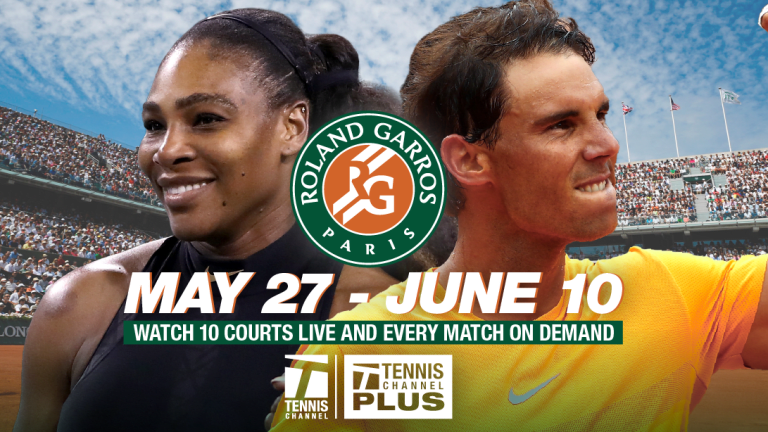The Argentine’s strengths were quite apparent in the opening set, one where del Potro frequently posed major questions on Nadal’s service games. In the first game of the match, Nadal went down love-30, but eventually held.
Nadal’s kingdom was even more imperiled at 1-all, when del Potro reached love-40. On two of those break points—the one at love-40 and at 30-40—Nadal revealed his deceptive versatility. On the first, he whipped an angled, crosscourt forehand winner. At 30-40, a bold serve and volley, Nadal poking a forehand volley with minimal authority but at least reasonable depth. Likely more shocked by the tactic than the weight of Nadal’s volley, del Potro netted the passing shot.
Another threat came at 2-all, Nadal again down love-30. Nadal avoided this crisis courtesy of two consecutive drop shots short to del Potro’s forehand. Given how far over del Potro was camping in his backhand corner, this was a good strategy that paid its share of dividends and in time, del Potro’s awareness of that threat heightened, opened up the court for more of Nadal’s pet shot, his crosscourt forehand.
Then came the pivotal game of the match. Nadal served at 4-all, 15-30. Anticipating Nadal’s wide serve—don’t we all?—the Argentine rolled a superb crosscourt backhand deep to Nadal’s forehand. Nadal replied with a crosscourt forehand of his own, but it was short enough for del Potro to pounce and lace a down-the-line backhand winner. 4-4, 15-40. Say hello once more to the drop shot. At 30-40, a tight del Potro badly misfired a forehand. But at deuce, del Potro earned another break point. As only he can, Nadal fought it off with a brutalizing inside-out forehand. At deuce, Nadal closed out a 13-ball baseline rally with a backhand crosscourt winner. The next point was rare and scintillating. Nadal opted to serve and volley, but struck a forehand drop volley too deep, giving del Potro the chance to line a passing shot at Nadal’s backhand volley. Nadal lunged, spit that one back—and then clipped an angled crosscourt forehand volley for a winner.
“And when you don't take your chances against the No. 1 in the world,” said del Potro, “you're in trouble.”
According to Nadal, “Today in the first set, for example, I was not playing great, was suffering because he was playing better than me.”
One aspect of Nadal’s genius is his ability to see both the short term—the point ahead of him, or better yet, the ball he must play immediately—and the long-term significance of maintaining durability. Inevitable as it may seem to once again see Nadal commanding the clay, recall that, in January, he had retired in the middle of his Australian Open quarterfinal and didn’t resume competing until this spring in Monte Carlo.
“I don't want to sound arrogant,” he said following the del Potro match. “I have never been arrogant. So what I simply mean is that even though you have to remain humble, you also have to give the value to whatever you're doing. It would be even more arrogant to think that all this is normal. I have to value what's happening to me. Three months ago, things were different.”
Per Nadal’s belief in suffering as a redemptive aspect of the competitive process, he had withstood so many of del Potro’s barrages, but now stood one game away from winning the first set. The dazzling urgency Nadal brings to crunchtime surfaced marvelously here, highlighted by an opening-point backhand crosscourt passing-shot winner, ample topspin off both sides throughout the game and finally, at 30-40, on Nadal’s second set point, a slice backhand that just kissed the line, and a high, deep backhand that del Potro netted. So what if del Potro had struck 11 winners in the first set? So what if in that 4-5 game, he’d gotten in all six of his first serves? Two minutes short of an hour, Nadal had taken the first set, 6-4.
Over the next 76 minutes, Nadal dropped just three more games, closing it out 6-1, 6-2. It was intriguing to watch Nadal build points against someone with as much artillery as del Potro. Besides the drop shot to del Potro’s forehand corner, Nadal mixed things up much like a boxer—frequent wide shots to the forehand, and, even more often, savage-like forehands to the del Potro backhand, closed out with yet another crosscourt drive or, once Nadal found proper space with his body and on the court, dynamic inside-out shots.
Nadal’s topspin and movement turned the rectangle of the court into a circle. These weren’t just body punches. This was being on one of those medieval torture racks, del Potro’s limbs being pulled to their limits. Less than a half hour into the match, the Argentine had called for the trainer to evaluate his hip. By the middle of the second set, he was looking like a shadow of the man who had started it.
Reflecting on his first chances, del Potro said, “Anyways, at least we can win a set, not the match. But Rafa is playing every point better from the beginning until the last point of the match, and his intensity very growing up during the match, and it's tough to be there all the time.”
In his effort to storm Nadal’s clay-court kingdom, del Potro had learned a cruel lesson: If you strike a king, you must kill him.
